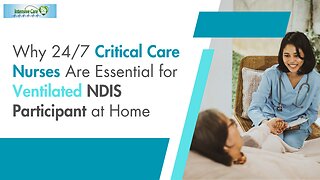Premium Only Content

Why Cerebral Palsy Adults&Children on BIPAP At Home Need 24/7 Critical Care Nurses (Evidence Based)!
Why Cerebral Palsy Adults&Children on BIPAP At Home Need 24/7 Critical Care Nurses (Evidence Based)!
Book your free 15-minute phone consultation here
http://intensivecarehotline.com/scheduling-appointment/
Call directly 24/7
+1 415-915-0090 USA/Canada
+44 118 324 3018 UK
+6141 094 2230 Australia
Email support@intensivecarehotline.com
Get 1:1 consulting and advocacy
1:1 phone counselling
http://intensivecarehotline.com/one-on-one-counselling/
Become a member for families of critically ill Patients in Intensive Care
https://intensivecarehotline.com/intensivecaresupport-org-membership/
Immediate action steps http://intensivecarehotline.com/take-control-take-charge/immediate-action-steps/
https://intensivecareathome.com
And if you need a medical record review, click on the link and we can help you with reviewing your loved one’s medical records while they’re in ICU.
https://intensivecarehotline.thrivecart.com/review-of-medical-records/
Facebook Page: https://www.facebook.com/ICUhotline
Twitter: https://twitter.com/icuhotline
Song: Jarico - Island Music
supported by@FreeBackgroundMusicForCreators
#BackgroundMusicWithoutLimitations
https://bit.ly/2XoXFnb
#icu
#intensivecare
#criticalcare
Hi, it’s Patrik Hutzel from intensivecareathome.com where we provide tailor-made solutions for long-term ventilated adults and children with tracheostomies at home and where we also provide tailor-made solutions for hospitals and intensive care units at home whilst providing quality care for long-term ventilated adults and children with tracheostomies at home, otherwise medically complex clients at home adults and children, which includes BIPAP (Bilevel Positive Airway Pressure), CPAP (Continuous Positive Airway Pressure) at home, home tracheostomy care for adults and children that are not ventilated, Home TPN (Total Parenteral Nutrition), home IV potassium infusions, home IV magnesium infusions as well as home IV antibiotics. We’re also providing port management, central line management, PICC (Peripherally Inserted Central Catheter) line management, as well as Hickman’s line management and we also provide palliative care at home.
We have also sent, and we continue to send our critical care nurses into the home for emergency department bypass services. We have done so successfully for the Western Sydney Local Area Health District, their in-touch program.
Now, today I want to talk more about why especially cerebral palsy children need BIPAP sometimes at home and if they do need BIPAP, why they need critical care nurses 24 hours a day. I can give you some real-world examples from some of our clients, but also from the cerebral palsy website.
A lot of cerebral palsy children end up with scoliosis and therefore their respiratory health is very compromised and breathing problems may arise, and a lot of the clients that we’ve worked with over the years with cerebral palsy end up on BIPAP or on CPAP, predominantly on BIPAP. But several things contribute to the need for BIPAP including aspiration often, which is caused by the weakness or spasticity in the digestive tract muscles, may also cause the breathing problems and the aspiration. Also, gastroesophageal reflux, which often ends up for those children having a fundoplication.
Pneumonia is often caused because there’s an unsatisfactory cough and respiratory tract infections are often caused because those kids cannot clear their secretions, and those infections can readily develop into a pneumonia. So how can that be managed? Once again, it can be managed with deep suctioning. For example, some kids need a nasopharyngeal airway, but that’s not often enough, deep suctioning is not often enough. The tidal volumes when someone is on BIPAP or CPAP can be quite small. With the small tidal volumes (the volumes that are going into the lungs), that’s the only way really that adequate ventilation is established and maintained.
I’ll give you another example. One of our clients who’s a child at home on BIPAP for cerebral palsy. The client has a Glasgow coma scale of about 7 out of 15, which means the client is neurologically very compromised and therefore, also has issues clearing the airway. So, a nasopharyngeal airway is regularly used to clear the airway, that means a nasopharyngeal airway is inserted into the nose and then deep suctioning is often applied to clear the secretions.
Continue reading at: https://intensivecareathome.com/why-cerebral-palsy-adults-children-on-bipap-bilevel-positive-airway-pressure-at-home-need-24-7-critical-care-nurses-evidence-based/
-
 12:59
12:59
Intensive Care at Home
22 days agoWhy 24/7 Critical Care Nurses Are Essential for Ventilated NDIS Participant at Home
31 -
 2:34:32
2:34:32
Badlands Media
4 days ago"CODEX 9/11" - Premiering Aug 24th, 6pm ET
186K142 -
 LIVE
LIVE
a12cat34dog
1 hour agoSOLID DAWG RETURNS :: METAL GEAR SOLID :: 1998 IS UNFORGIVING {18+}
128 watching -
 LIVE
LIVE
Lofi Girl
2 years agolofi hip hop radio 📚 - beats to relax/study to
113 watching -
 1:53:43
1:53:43
Nerdrotic
4 hours ago $0.16 earnedMysteries of 3I/ATLAS | Forbidden Frontier #113
20K3 -
 2:04:21
2:04:21
vivafrei
23 hours agoEp. 278: D.C. Peace Wave! Big Tish & Nipple Judge SPANKED! "Maryland Man" Trafficker FREE & MORE?
57.8K66 -
 LIVE
LIVE
Patriots With Grit
3 hours agoWhat You Should Know: Harmful Vaccine Ingredients | Dr. Bryan Ardis, D.C.
26 watching -
 LIVE
LIVE
yellow_1ron
2 hours agoGAMING WITH THE HOMIES JOIN UP | JOIN!
107 watching -
 LIVE
LIVE
JohnnyDrop
1 hour agoJOHNNY DROP | Let's get to 100 Followers | Warzone / PGA / Question of the Day
42 watching -
 11:52
11:52
Exploring With Nug
3 hours ago $0.07 earnedWhat’s Hiding Under This Dallas Lake We Found a Vehicle!
14.6K3